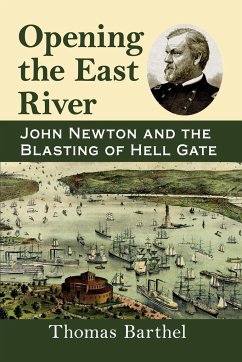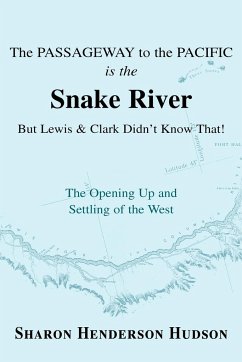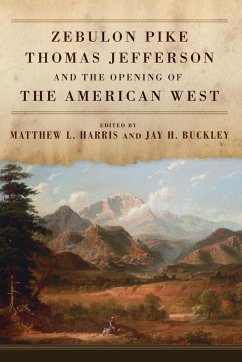- Broschiertes Buch
- Merkliste
- Auf die Merkliste
- Bewerten Bewerten
- Teilen
- Produkt teilen
- Produkterinnerung
- Produkterinnerung
After the Civil War, the New York City's East River was a massive unsolved and dangerous navigation problem. A major waterway into and out of the Harbor--where customs revenue equaled 42 percent of the U.S. Government's income--the river's many hindrances, centered around Hell Gate, included whirlpools, rocks and reefs. These, combined with swirling currents and powerful tides, led to deaths, cargo losses and destruction of vessels. Charged with clearing the river, General John Newton of the Army Corps of Engineers went to work with the most rudimentary tools for diving, mining, lighting,…mehr
Andere Kunden interessierten sich auch für
![The Passageway to the Pacific Is the Snake River But Lewis and Clark Didn't Know That! the Opening Up and Settling of the West The Passageway to the Pacific Is the Snake River But Lewis and Clark Didn't Know That! the Opening Up and Settling of the West]() Sharon Henderson HudsonThe Passageway to the Pacific Is the Snake River But Lewis and Clark Didn't Know That! the Opening Up and Settling of the West13,99 €
Sharon Henderson HudsonThe Passageway to the Pacific Is the Snake River But Lewis and Clark Didn't Know That! the Opening Up and Settling of the West13,99 €![The Nez Perce Indians and the Opening of the Northwest The Nez Perce Indians and the Opening of the Northwest]() Alvin M. Jr. JosephyThe Nez Perce Indians and the Opening of the Northwest33,99 €
Alvin M. Jr. JosephyThe Nez Perce Indians and the Opening of the Northwest33,99 €![Life on the Potomac River Life on the Potomac River]() Edwin W. BeitzellLife on the Potomac River46,99 €
Edwin W. BeitzellLife on the Potomac River46,99 €![Opening New Markets Opening New Markets]() Walter S. Jr. DunnOpening New Markets94,99 €
Walter S. Jr. DunnOpening New Markets94,99 €![Steamboats on the Hudson River Steamboats on the Hudson River]() William H. Jr. EwenSteamboats on the Hudson River22,99 €
William H. Jr. EwenSteamboats on the Hudson River22,99 €![Zebulon Pike, Thomas Jefferson, and the Opening of the American West Zebulon Pike, Thomas Jefferson, and the Opening of the American West]() Zebulon Pike, Thomas Jefferson, and the Opening of the American West28,99 €
Zebulon Pike, Thomas Jefferson, and the Opening of the American West28,99 €![Black River in the North Country Black River in the North Country]() Black River in the North Country17,99 €
Black River in the North Country17,99 €-
-
-
After the Civil War, the New York City's East River was a massive unsolved and dangerous navigation problem. A major waterway into and out of the Harbor--where customs revenue equaled 42 percent of the U.S. Government's income--the river's many hindrances, centered around Hell Gate, included whirlpools, rocks and reefs. These, combined with swirling currents and powerful tides, led to deaths, cargo losses and destruction of vessels. Charged with clearing the river, General John Newton of the Army Corps of Engineers went to work with the most rudimentary tools for diving, mining, lighting, pumping and drilling. His crews worked for 20 years, using a steam-drilling scow of his own design and a new and perilous explosive--nitroglycerine. In 1885, Newton destroyed the nine-acre Flood Rock with 282,730 pounds of high explosives. The demolition was watched by tens of thousands. This book chronicles the clearing of the East River and the ingenuity of the Army engineer whose work was praised by the National Academy of Sciences.
Produktdetails
- Produktdetails
- Verlag: McFarland and Company, Inc.
- Seitenzahl: 238
- Erscheinungstermin: 31. August 2021
- Englisch
- Abmessung: 229mm x 152mm x 14mm
- Gewicht: 393g
- ISBN-13: 9781476682983
- ISBN-10: 1476682984
- Artikelnr.: 64196130
- Verlag: McFarland and Company, Inc.
- Seitenzahl: 238
- Erscheinungstermin: 31. August 2021
- Englisch
- Abmessung: 229mm x 152mm x 14mm
- Gewicht: 393g
- ISBN-13: 9781476682983
- ISBN-10: 1476682984
- Artikelnr.: 64196130
Thomas Barthel, a professor emeritus in the State University of New York system, has written nine books on subjects ranging from the Civil War, to baseball history to civil engineering. He lives in Clinton, New York.
Table of Contents
Preface
Introduction
One. A City of Islands
Travel on Land
New York, a Maritime City
The Sandy Hook Problem
The East River Passage
Fulton on the Hudson
Clinton's Ditch
Shipbuilding, Commerce and New York City
Famed Ships and Shipbuilders
Two. The Business of the City
Some Studies Are Begun
The Channels of the East River
From Throgs Neck to Little Hell Gate
Little Hell Gate
Hallet's Point Reef
Changes in Ships and Ship Building
The First Glimmer of Funds
Coasters
Maillefert at Work
The Politics of Funding
Three. General Newton Takes Command
Newton Is Chosen
The City Changes
Ferries, Pilots, and The News
Newton Designs the Projects
Some Solutions, Some Problems
Newton Includes Nitroglycerin
Four. Newton's Needs
Planning and Progress
Hazards and Virtues of Nitroglycerine
The East River Association
At Work with Sidney Shelbourne and Benjamin S.H. Maillefert Again
The Case of the Thatcher Magoun
Work Begins on the Reef at Hallet's Point
Five. Newton Adapts
The First Steps
Ships and Vanderbilt's Trains
Dockage and Piers
Despite Nitroglycerine's Deadly Accidents Newton Trusts It
Newton's Confidence
Six. Newton's Marvelous Machine
The Creation of Newton's Steam Drilling Scow
Nitroglycerine Is Studied
The Handling, Transportation and Storage of Nitroglycerine
Newton Adapts to the Steam Drill
The Railroads Show Their Promise
Hallet's Point Reef: The Tools and the Workers
Interested Parties
The Danger Remains; the Funds Arrive
Seven. The Scow at Work
Progress with Some Obstacles in the River
Changes in Ships Verify Newton's Work on the River
The Importance of Julius H. Striedinger
Newton's Refining of the Scow's Operations
The Accidents Continue and the Tunnels Move Under the River
Improvements in Steam Drills and Other Tools
Eight. The Long Depression Begins
The Work Goes On Even as the Appropriations Fall Short
Newton's Additional Duties on the Hudson as the Economy Crashes
Advantages and Dangers of Nitroglycerine
Divers and the Positioning of Explosives
Changes and Adaptations in American Shipping
Hallet's Point Reef Preparation Continues
Newton's Jurisdiction Extends into Vermont
Explosives, Fuses and Continuing Dangers
The Newton Steam Drilling Scow at Work
Changes in Newton's Plan
Two Rocks and a Reef: The Frying Pan, Way's Reef, and Pot Rock
Spuyten Duyvel and the Harlem River
Up and Down the River
Close to the Finish
Nine. Newton's Many Plans
The Country Is Attentive
Hallet's Point Reef
A Decision on Explosives
Making the Cartridges
Wiring the Cartridges
Connecting the Wires
The Danger Remained
The City Reacts
Ten. Newton's Triumph of Science
The Crowds Assemble
Blast Time
Reaction and Judgment
Eleven. Newton's Aim of 26 Feet
Newton's Second Decade
Some Results
A Challenge
Newton's Argument
Delays at Hell Gate
The New York Central
The Delays Go On
The Harlem River Studied Again
Twelve. Newton's Work Slows
Newton's Strategy
Progress at Flood Rock
Expanding the Site
Newton Considers
Interest Increases
Other Projects at the Same Time
The Working Force
Slowdown of 1882-1883
Newton in Charge
Thirteen. Newton Readies the Explosion
Strategies Are Decided
Preparing the Cartridges
Installing the Cartridges
The Guests and the Police
Explosions Explained
Fourteen. Newton's Violent Triumph
Saturday Night Preparations Before the Sunday Blast
Sunday Morning's Tasks
Blast Time
Newton Arrives at the Firing Point
After the Blast
Estimates of Work to Be Done
Some Measurements of the Explosion
Fifteen. Newton's Last Decade
Death
Honors
A Gazetteer of the East River Obstructions
Chapter Notes
Bibliography
Index
Preface
Introduction
One. A City of Islands
Travel on Land
New York, a Maritime City
The Sandy Hook Problem
The East River Passage
Fulton on the Hudson
Clinton's Ditch
Shipbuilding, Commerce and New York City
Famed Ships and Shipbuilders
Two. The Business of the City
Some Studies Are Begun
The Channels of the East River
From Throgs Neck to Little Hell Gate
Little Hell Gate
Hallet's Point Reef
Changes in Ships and Ship Building
The First Glimmer of Funds
Coasters
Maillefert at Work
The Politics of Funding
Three. General Newton Takes Command
Newton Is Chosen
The City Changes
Ferries, Pilots, and The News
Newton Designs the Projects
Some Solutions, Some Problems
Newton Includes Nitroglycerin
Four. Newton's Needs
Planning and Progress
Hazards and Virtues of Nitroglycerine
The East River Association
At Work with Sidney Shelbourne and Benjamin S.H. Maillefert Again
The Case of the Thatcher Magoun
Work Begins on the Reef at Hallet's Point
Five. Newton Adapts
The First Steps
Ships and Vanderbilt's Trains
Dockage and Piers
Despite Nitroglycerine's Deadly Accidents Newton Trusts It
Newton's Confidence
Six. Newton's Marvelous Machine
The Creation of Newton's Steam Drilling Scow
Nitroglycerine Is Studied
The Handling, Transportation and Storage of Nitroglycerine
Newton Adapts to the Steam Drill
The Railroads Show Their Promise
Hallet's Point Reef: The Tools and the Workers
Interested Parties
The Danger Remains; the Funds Arrive
Seven. The Scow at Work
Progress with Some Obstacles in the River
Changes in Ships Verify Newton's Work on the River
The Importance of Julius H. Striedinger
Newton's Refining of the Scow's Operations
The Accidents Continue and the Tunnels Move Under the River
Improvements in Steam Drills and Other Tools
Eight. The Long Depression Begins
The Work Goes On Even as the Appropriations Fall Short
Newton's Additional Duties on the Hudson as the Economy Crashes
Advantages and Dangers of Nitroglycerine
Divers and the Positioning of Explosives
Changes and Adaptations in American Shipping
Hallet's Point Reef Preparation Continues
Newton's Jurisdiction Extends into Vermont
Explosives, Fuses and Continuing Dangers
The Newton Steam Drilling Scow at Work
Changes in Newton's Plan
Two Rocks and a Reef: The Frying Pan, Way's Reef, and Pot Rock
Spuyten Duyvel and the Harlem River
Up and Down the River
Close to the Finish
Nine. Newton's Many Plans
The Country Is Attentive
Hallet's Point Reef
A Decision on Explosives
Making the Cartridges
Wiring the Cartridges
Connecting the Wires
The Danger Remained
The City Reacts
Ten. Newton's Triumph of Science
The Crowds Assemble
Blast Time
Reaction and Judgment
Eleven. Newton's Aim of 26 Feet
Newton's Second Decade
Some Results
A Challenge
Newton's Argument
Delays at Hell Gate
The New York Central
The Delays Go On
The Harlem River Studied Again
Twelve. Newton's Work Slows
Newton's Strategy
Progress at Flood Rock
Expanding the Site
Newton Considers
Interest Increases
Other Projects at the Same Time
The Working Force
Slowdown of 1882-1883
Newton in Charge
Thirteen. Newton Readies the Explosion
Strategies Are Decided
Preparing the Cartridges
Installing the Cartridges
The Guests and the Police
Explosions Explained
Fourteen. Newton's Violent Triumph
Saturday Night Preparations Before the Sunday Blast
Sunday Morning's Tasks
Blast Time
Newton Arrives at the Firing Point
After the Blast
Estimates of Work to Be Done
Some Measurements of the Explosion
Fifteen. Newton's Last Decade
Death
Honors
A Gazetteer of the East River Obstructions
Chapter Notes
Bibliography
Index
Table of Contents
Preface
Introduction
One. A City of Islands
Travel on Land
New York, a Maritime City
The Sandy Hook Problem
The East River Passage
Fulton on the Hudson
Clinton's Ditch
Shipbuilding, Commerce and New York City
Famed Ships and Shipbuilders
Two. The Business of the City
Some Studies Are Begun
The Channels of the East River
From Throgs Neck to Little Hell Gate
Little Hell Gate
Hallet's Point Reef
Changes in Ships and Ship Building
The First Glimmer of Funds
Coasters
Maillefert at Work
The Politics of Funding
Three. General Newton Takes Command
Newton Is Chosen
The City Changes
Ferries, Pilots, and The News
Newton Designs the Projects
Some Solutions, Some Problems
Newton Includes Nitroglycerin
Four. Newton's Needs
Planning and Progress
Hazards and Virtues of Nitroglycerine
The East River Association
At Work with Sidney Shelbourne and Benjamin S.H. Maillefert Again
The Case of the Thatcher Magoun
Work Begins on the Reef at Hallet's Point
Five. Newton Adapts
The First Steps
Ships and Vanderbilt's Trains
Dockage and Piers
Despite Nitroglycerine's Deadly Accidents Newton Trusts It
Newton's Confidence
Six. Newton's Marvelous Machine
The Creation of Newton's Steam Drilling Scow
Nitroglycerine Is Studied
The Handling, Transportation and Storage of Nitroglycerine
Newton Adapts to the Steam Drill
The Railroads Show Their Promise
Hallet's Point Reef: The Tools and the Workers
Interested Parties
The Danger Remains; the Funds Arrive
Seven. The Scow at Work
Progress with Some Obstacles in the River
Changes in Ships Verify Newton's Work on the River
The Importance of Julius H. Striedinger
Newton's Refining of the Scow's Operations
The Accidents Continue and the Tunnels Move Under the River
Improvements in Steam Drills and Other Tools
Eight. The Long Depression Begins
The Work Goes On Even as the Appropriations Fall Short
Newton's Additional Duties on the Hudson as the Economy Crashes
Advantages and Dangers of Nitroglycerine
Divers and the Positioning of Explosives
Changes and Adaptations in American Shipping
Hallet's Point Reef Preparation Continues
Newton's Jurisdiction Extends into Vermont
Explosives, Fuses and Continuing Dangers
The Newton Steam Drilling Scow at Work
Changes in Newton's Plan
Two Rocks and a Reef: The Frying Pan, Way's Reef, and Pot Rock
Spuyten Duyvel and the Harlem River
Up and Down the River
Close to the Finish
Nine. Newton's Many Plans
The Country Is Attentive
Hallet's Point Reef
A Decision on Explosives
Making the Cartridges
Wiring the Cartridges
Connecting the Wires
The Danger Remained
The City Reacts
Ten. Newton's Triumph of Science
The Crowds Assemble
Blast Time
Reaction and Judgment
Eleven. Newton's Aim of 26 Feet
Newton's Second Decade
Some Results
A Challenge
Newton's Argument
Delays at Hell Gate
The New York Central
The Delays Go On
The Harlem River Studied Again
Twelve. Newton's Work Slows
Newton's Strategy
Progress at Flood Rock
Expanding the Site
Newton Considers
Interest Increases
Other Projects at the Same Time
The Working Force
Slowdown of 1882-1883
Newton in Charge
Thirteen. Newton Readies the Explosion
Strategies Are Decided
Preparing the Cartridges
Installing the Cartridges
The Guests and the Police
Explosions Explained
Fourteen. Newton's Violent Triumph
Saturday Night Preparations Before the Sunday Blast
Sunday Morning's Tasks
Blast Time
Newton Arrives at the Firing Point
After the Blast
Estimates of Work to Be Done
Some Measurements of the Explosion
Fifteen. Newton's Last Decade
Death
Honors
A Gazetteer of the East River Obstructions
Chapter Notes
Bibliography
Index
Preface
Introduction
One. A City of Islands
Travel on Land
New York, a Maritime City
The Sandy Hook Problem
The East River Passage
Fulton on the Hudson
Clinton's Ditch
Shipbuilding, Commerce and New York City
Famed Ships and Shipbuilders
Two. The Business of the City
Some Studies Are Begun
The Channels of the East River
From Throgs Neck to Little Hell Gate
Little Hell Gate
Hallet's Point Reef
Changes in Ships and Ship Building
The First Glimmer of Funds
Coasters
Maillefert at Work
The Politics of Funding
Three. General Newton Takes Command
Newton Is Chosen
The City Changes
Ferries, Pilots, and The News
Newton Designs the Projects
Some Solutions, Some Problems
Newton Includes Nitroglycerin
Four. Newton's Needs
Planning and Progress
Hazards and Virtues of Nitroglycerine
The East River Association
At Work with Sidney Shelbourne and Benjamin S.H. Maillefert Again
The Case of the Thatcher Magoun
Work Begins on the Reef at Hallet's Point
Five. Newton Adapts
The First Steps
Ships and Vanderbilt's Trains
Dockage and Piers
Despite Nitroglycerine's Deadly Accidents Newton Trusts It
Newton's Confidence
Six. Newton's Marvelous Machine
The Creation of Newton's Steam Drilling Scow
Nitroglycerine Is Studied
The Handling, Transportation and Storage of Nitroglycerine
Newton Adapts to the Steam Drill
The Railroads Show Their Promise
Hallet's Point Reef: The Tools and the Workers
Interested Parties
The Danger Remains; the Funds Arrive
Seven. The Scow at Work
Progress with Some Obstacles in the River
Changes in Ships Verify Newton's Work on the River
The Importance of Julius H. Striedinger
Newton's Refining of the Scow's Operations
The Accidents Continue and the Tunnels Move Under the River
Improvements in Steam Drills and Other Tools
Eight. The Long Depression Begins
The Work Goes On Even as the Appropriations Fall Short
Newton's Additional Duties on the Hudson as the Economy Crashes
Advantages and Dangers of Nitroglycerine
Divers and the Positioning of Explosives
Changes and Adaptations in American Shipping
Hallet's Point Reef Preparation Continues
Newton's Jurisdiction Extends into Vermont
Explosives, Fuses and Continuing Dangers
The Newton Steam Drilling Scow at Work
Changes in Newton's Plan
Two Rocks and a Reef: The Frying Pan, Way's Reef, and Pot Rock
Spuyten Duyvel and the Harlem River
Up and Down the River
Close to the Finish
Nine. Newton's Many Plans
The Country Is Attentive
Hallet's Point Reef
A Decision on Explosives
Making the Cartridges
Wiring the Cartridges
Connecting the Wires
The Danger Remained
The City Reacts
Ten. Newton's Triumph of Science
The Crowds Assemble
Blast Time
Reaction and Judgment
Eleven. Newton's Aim of 26 Feet
Newton's Second Decade
Some Results
A Challenge
Newton's Argument
Delays at Hell Gate
The New York Central
The Delays Go On
The Harlem River Studied Again
Twelve. Newton's Work Slows
Newton's Strategy
Progress at Flood Rock
Expanding the Site
Newton Considers
Interest Increases
Other Projects at the Same Time
The Working Force
Slowdown of 1882-1883
Newton in Charge
Thirteen. Newton Readies the Explosion
Strategies Are Decided
Preparing the Cartridges
Installing the Cartridges
The Guests and the Police
Explosions Explained
Fourteen. Newton's Violent Triumph
Saturday Night Preparations Before the Sunday Blast
Sunday Morning's Tasks
Blast Time
Newton Arrives at the Firing Point
After the Blast
Estimates of Work to Be Done
Some Measurements of the Explosion
Fifteen. Newton's Last Decade
Death
Honors
A Gazetteer of the East River Obstructions
Chapter Notes
Bibliography
Index








